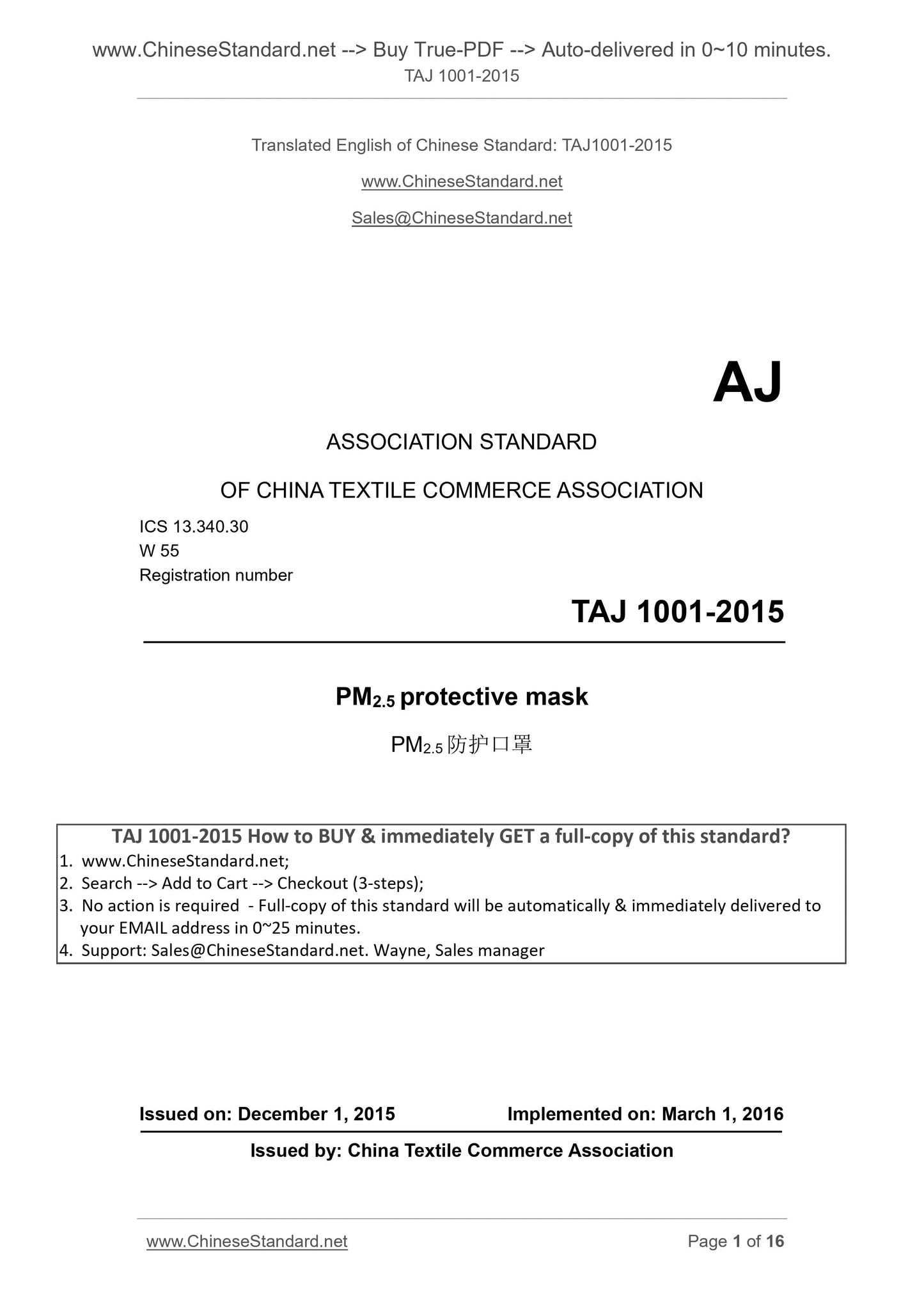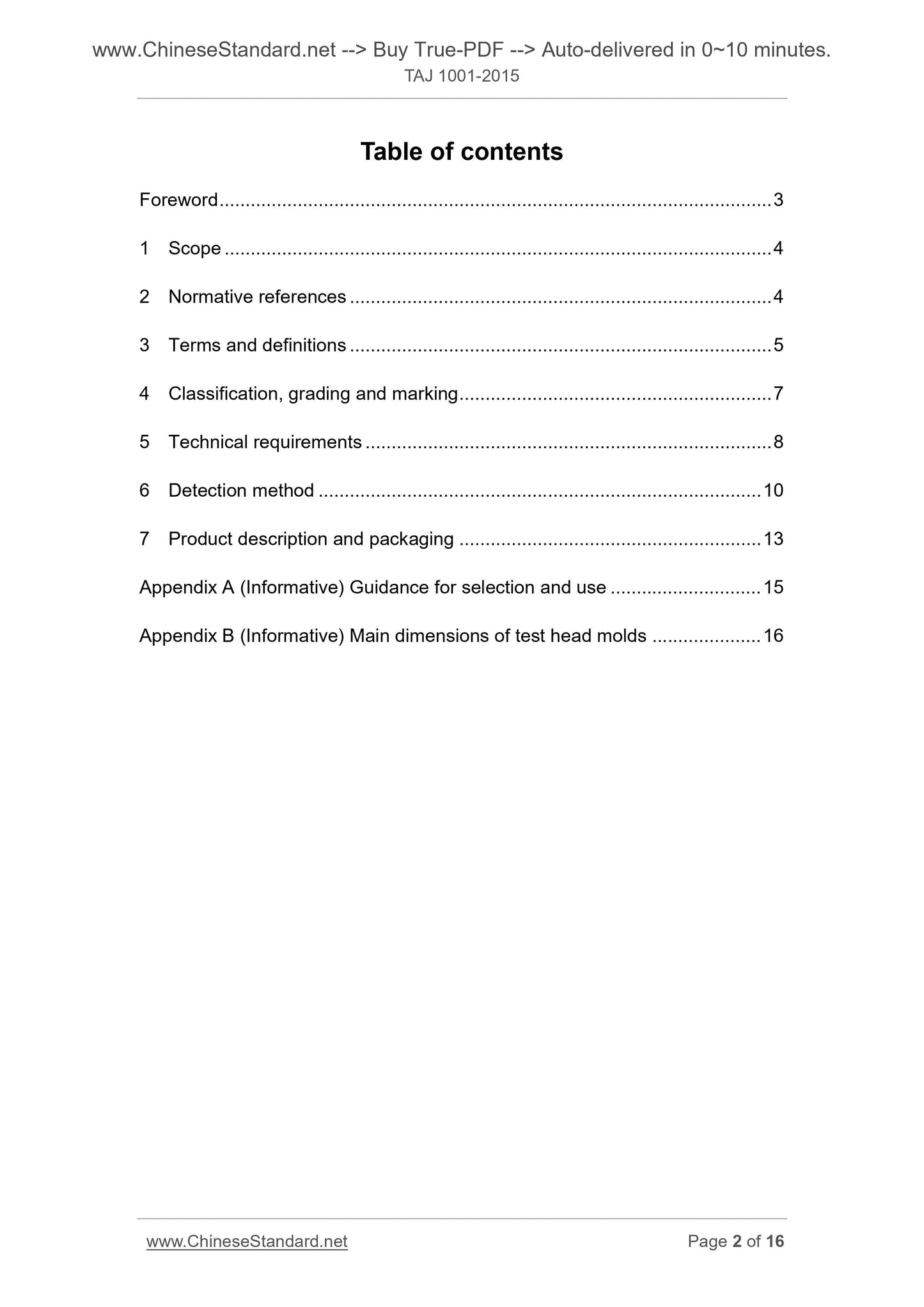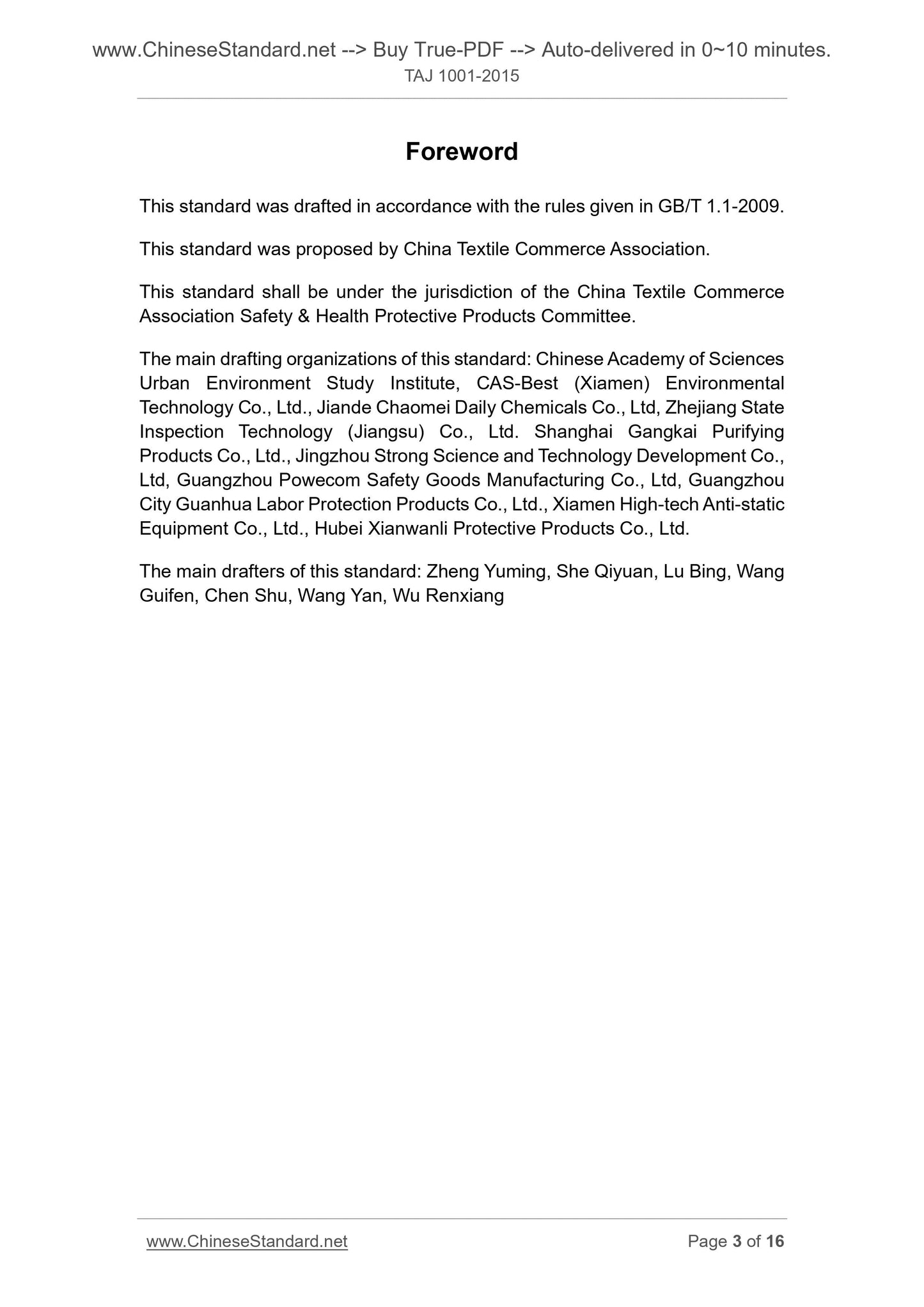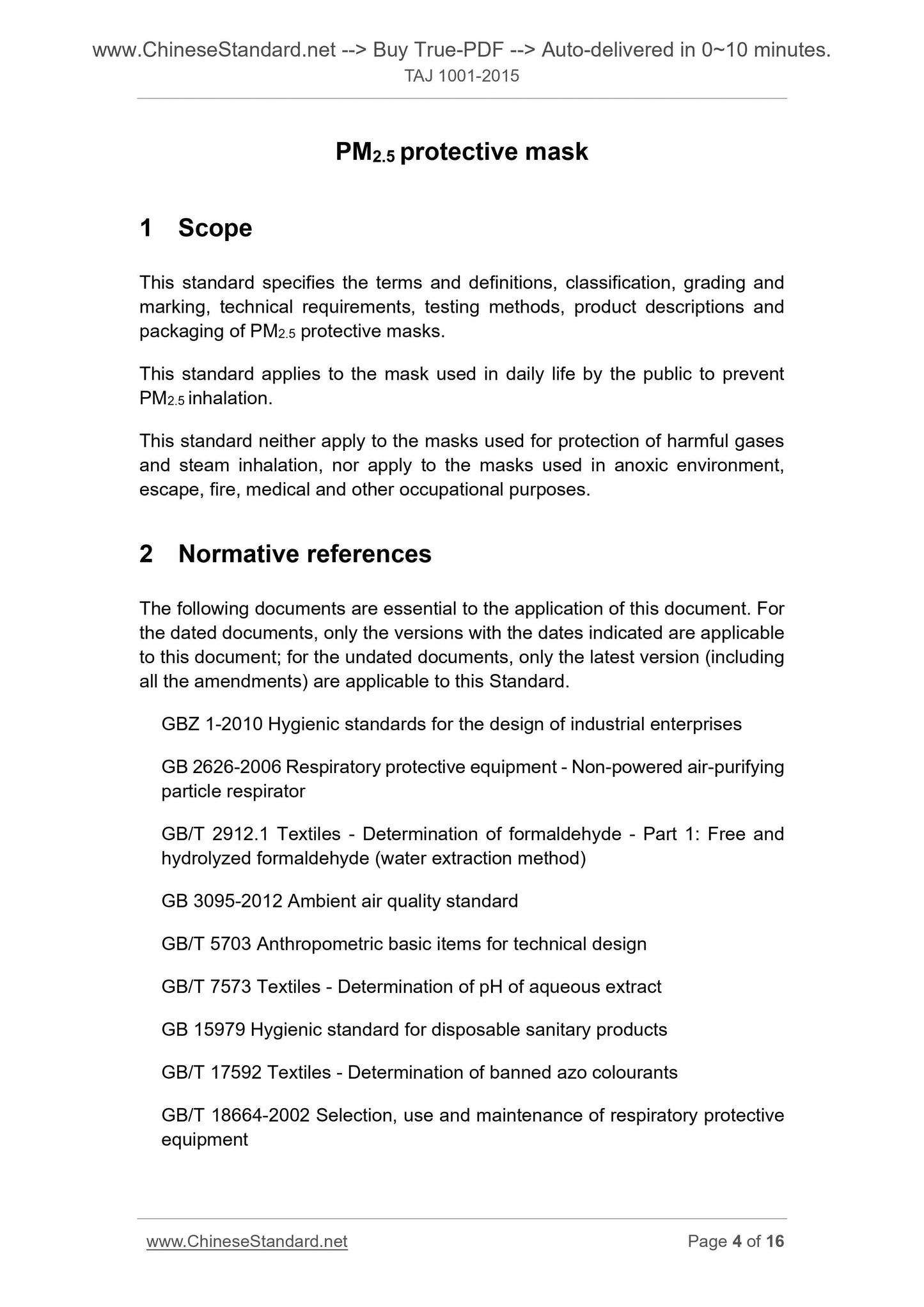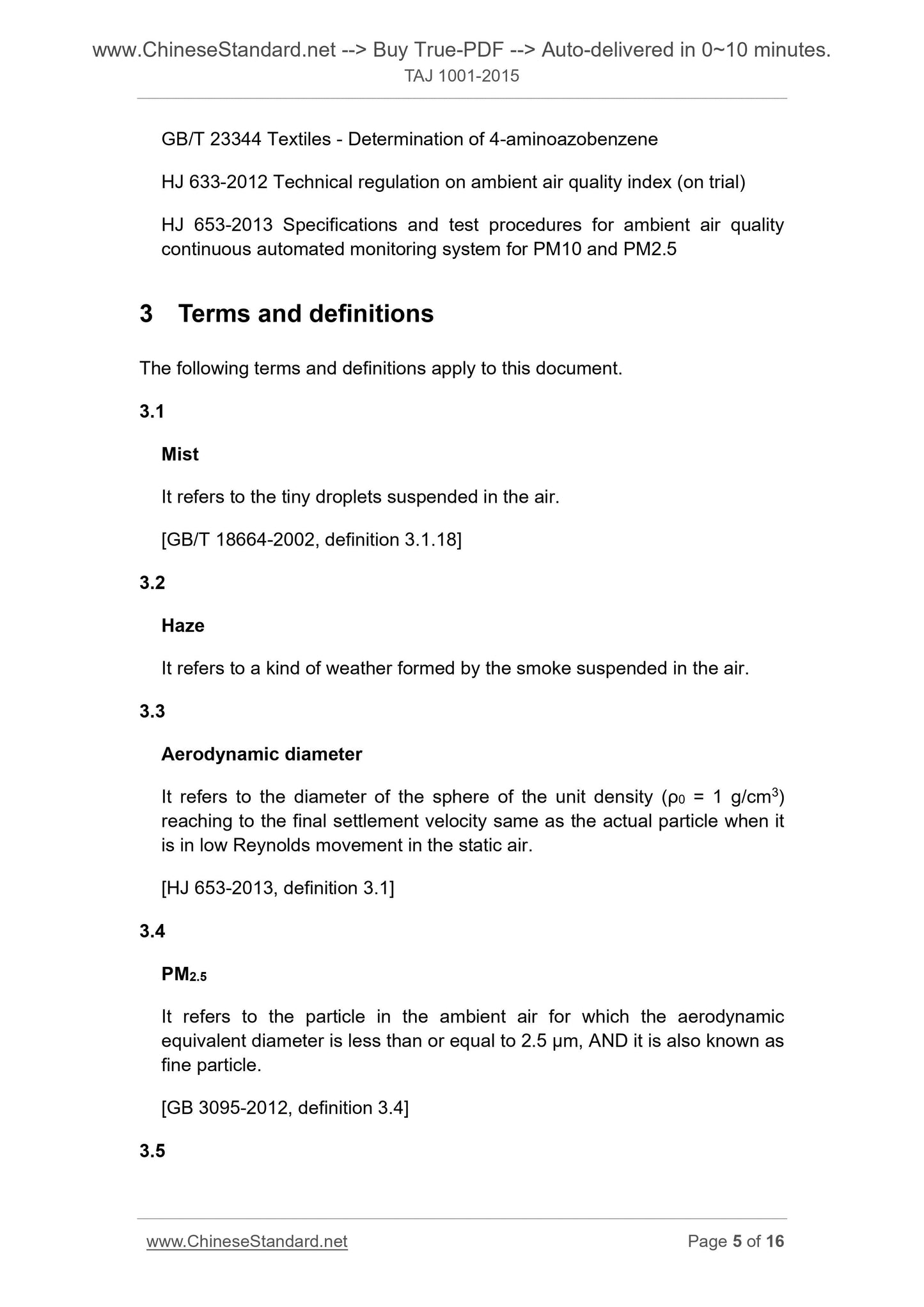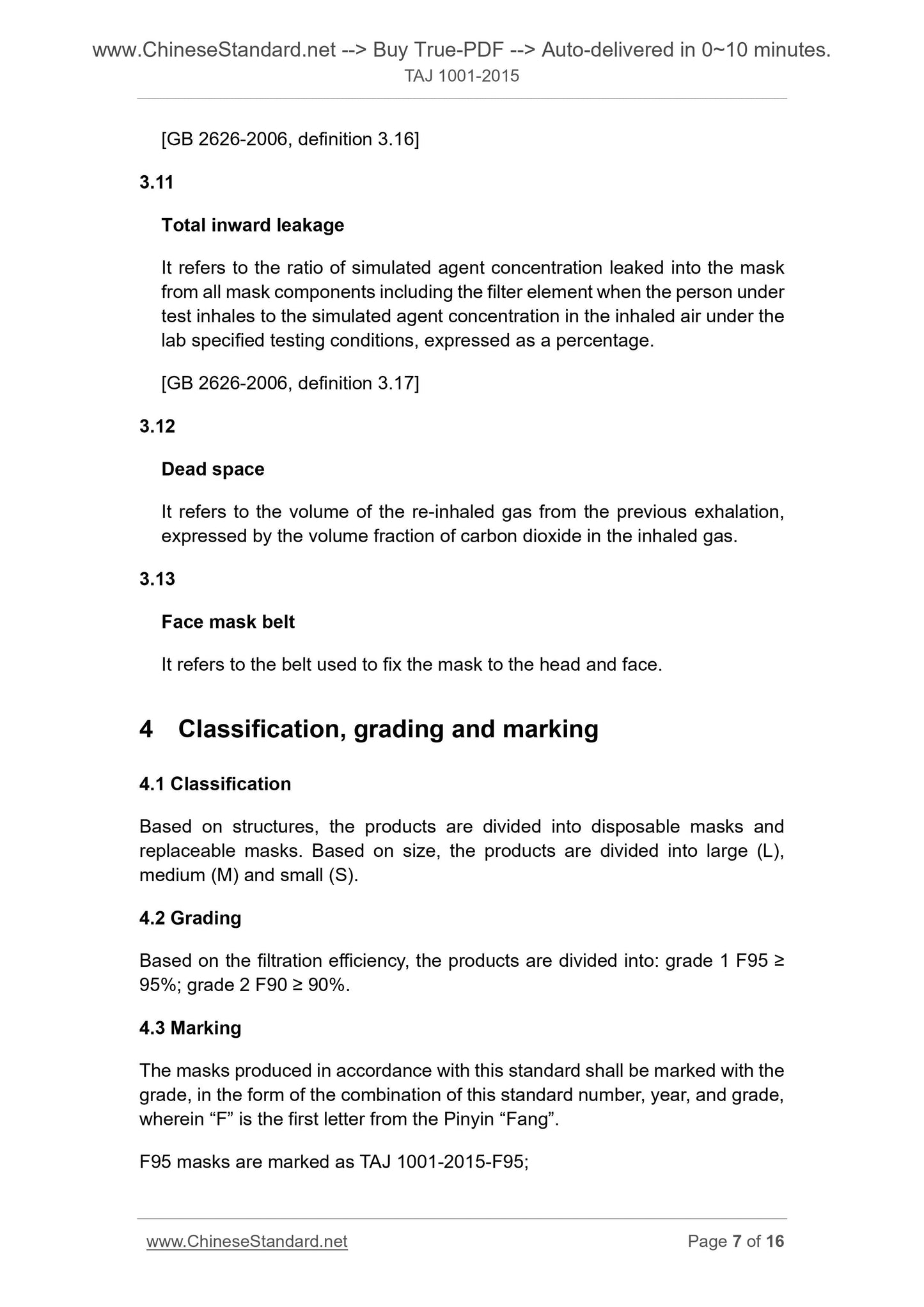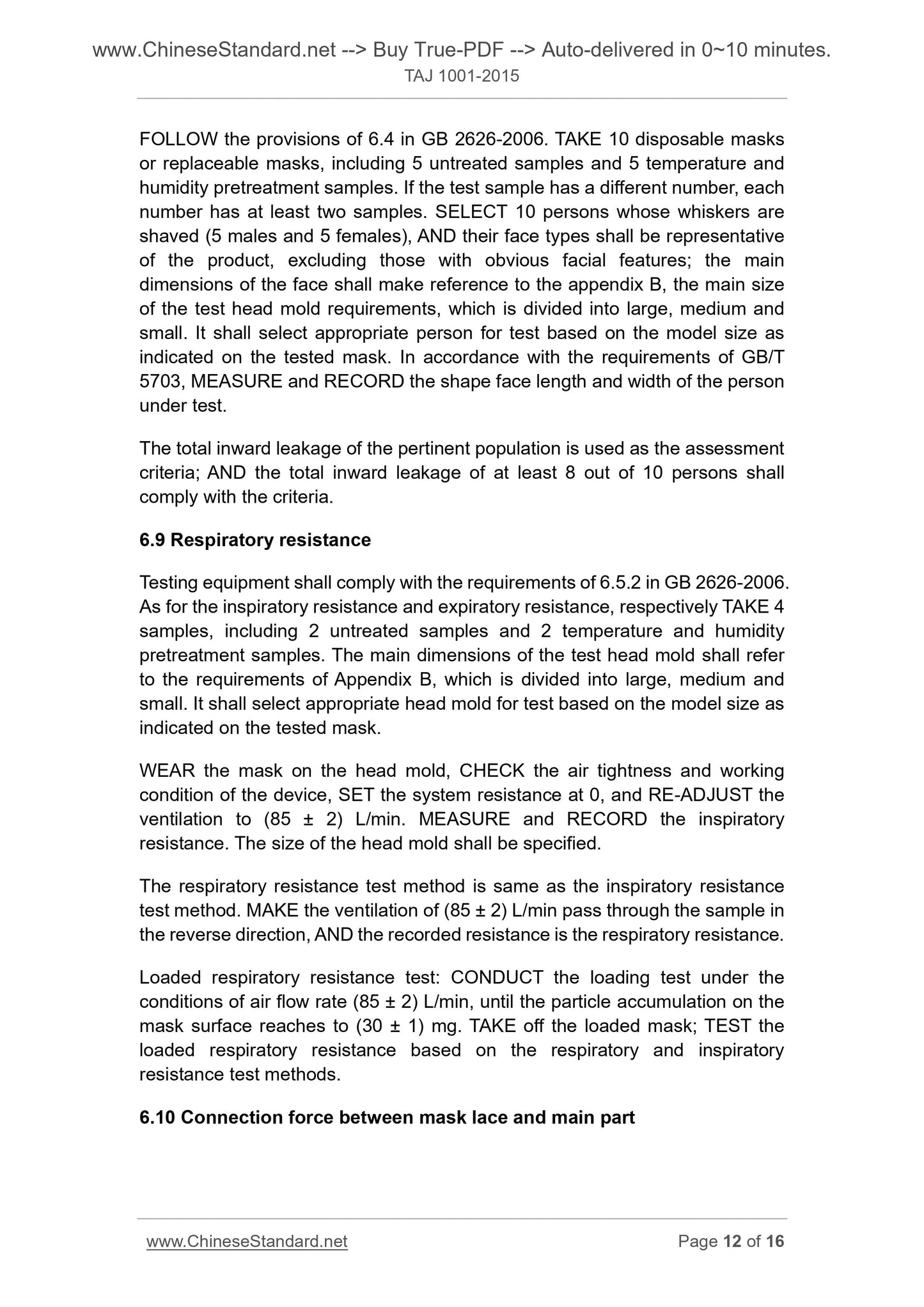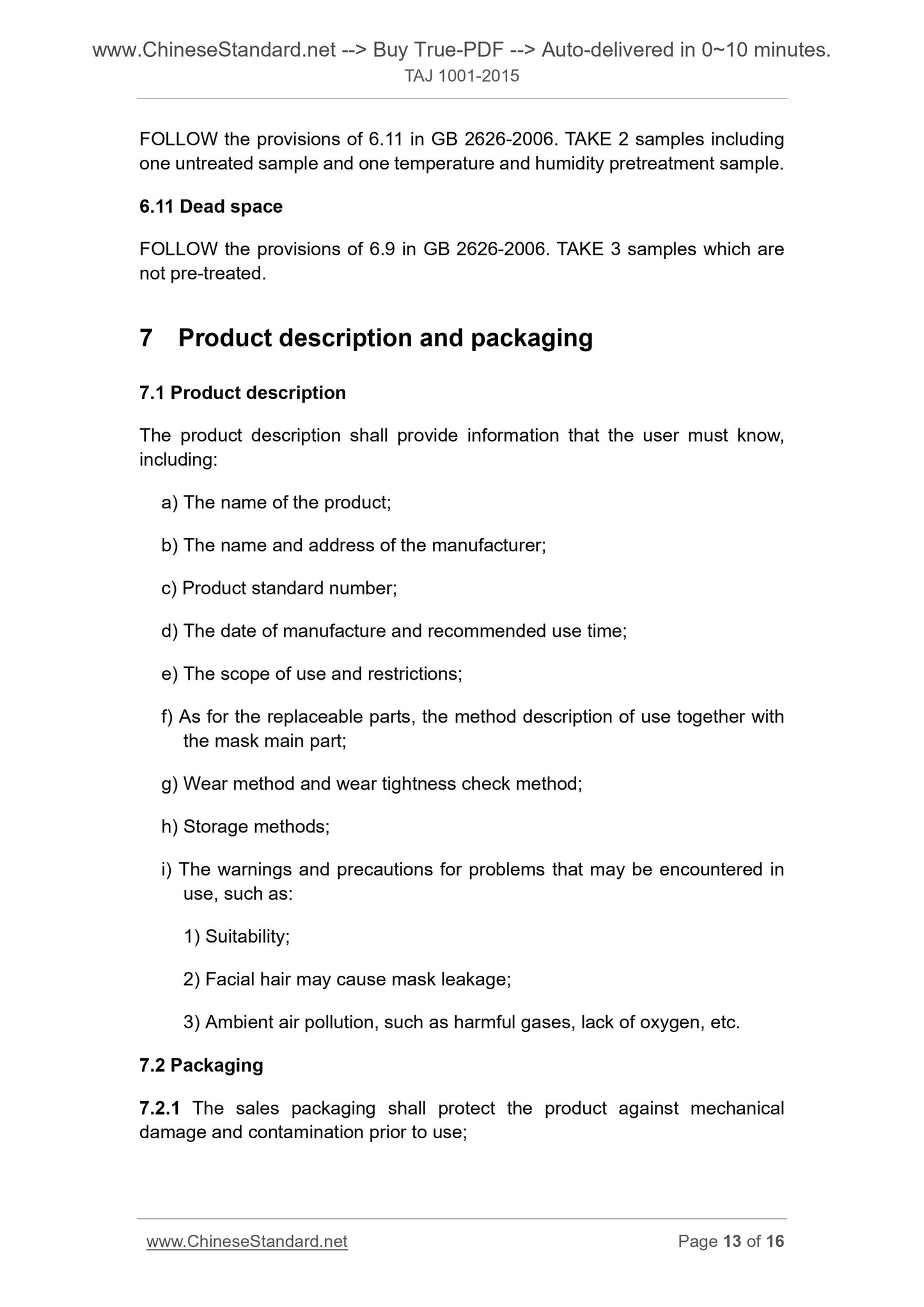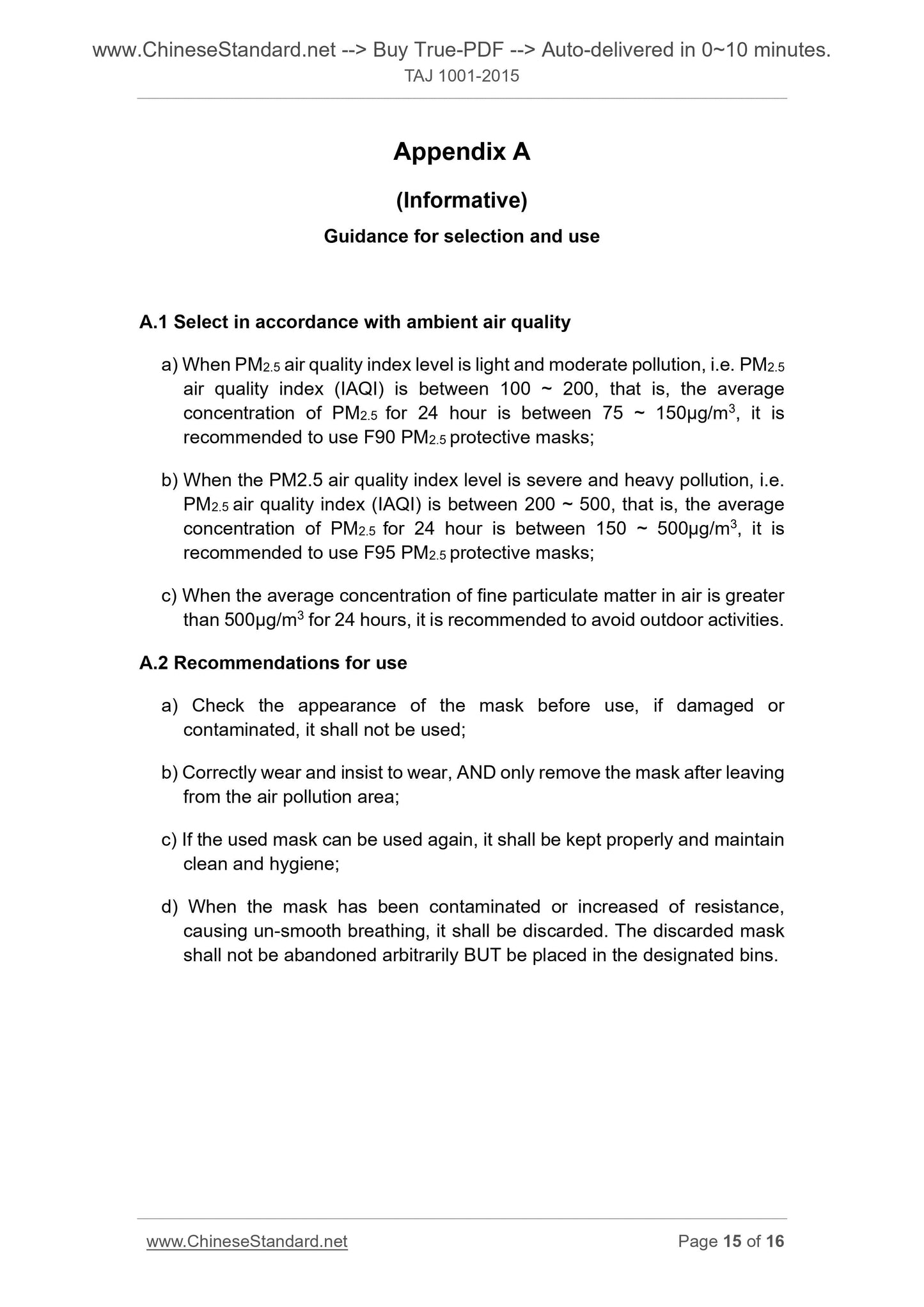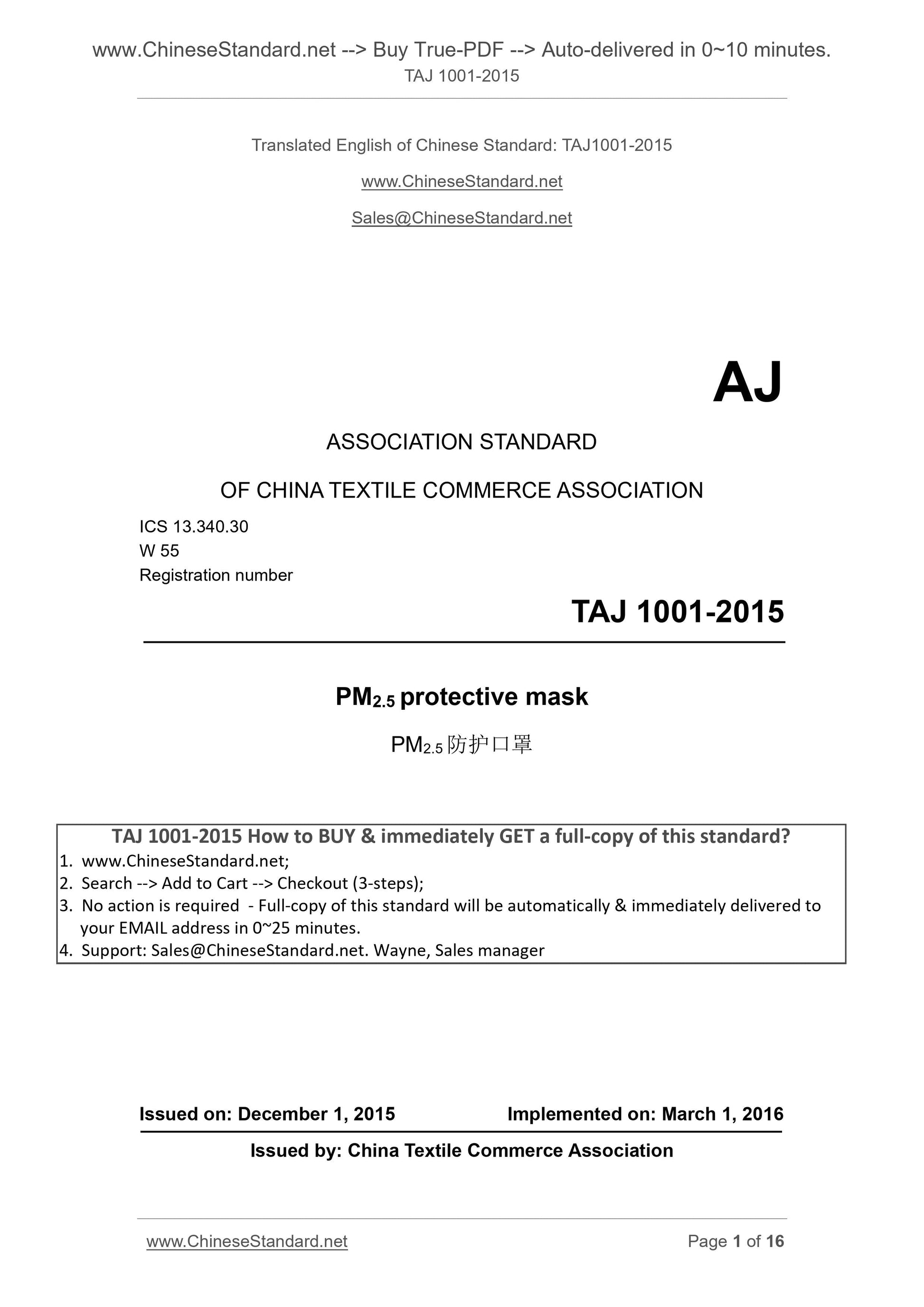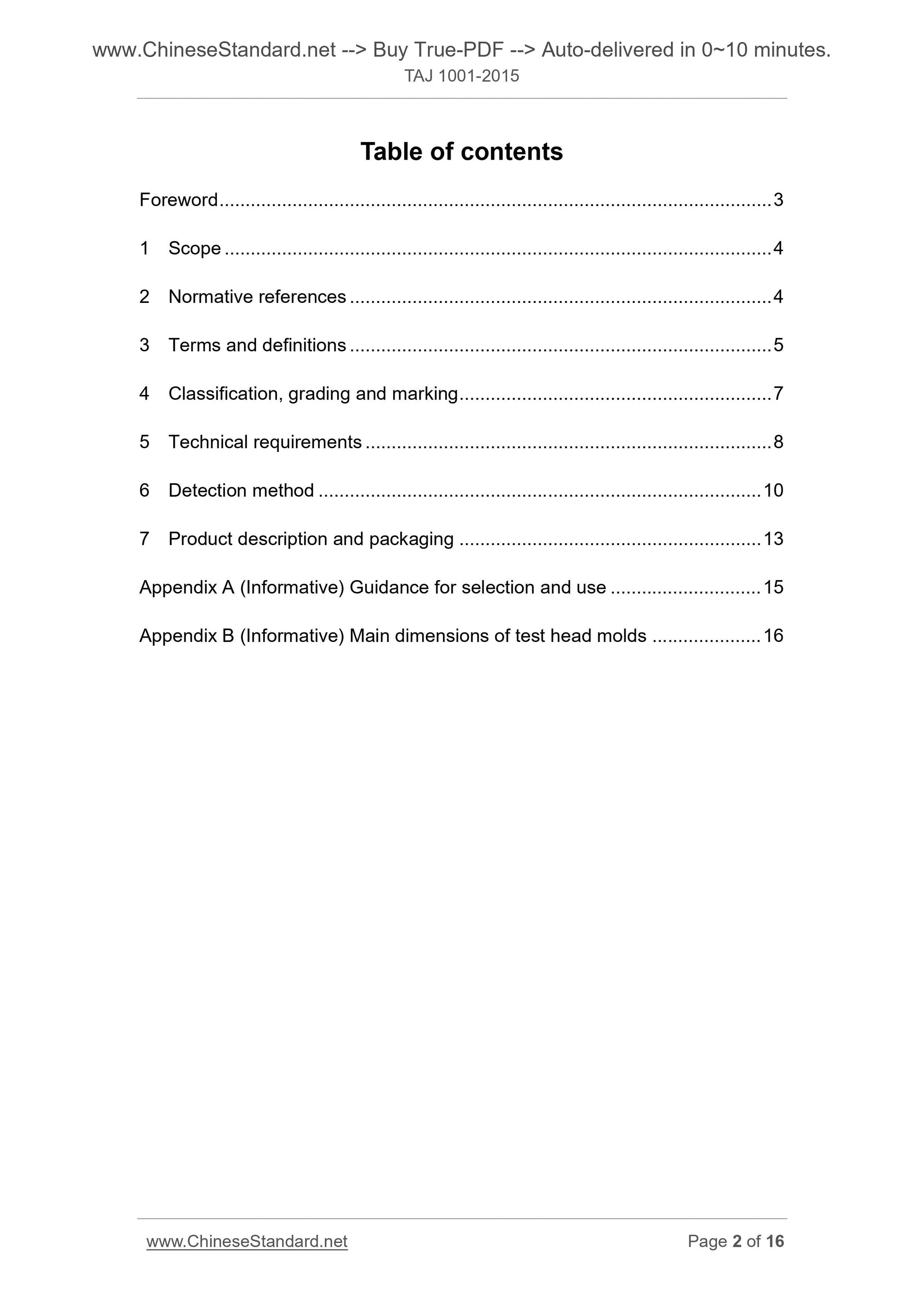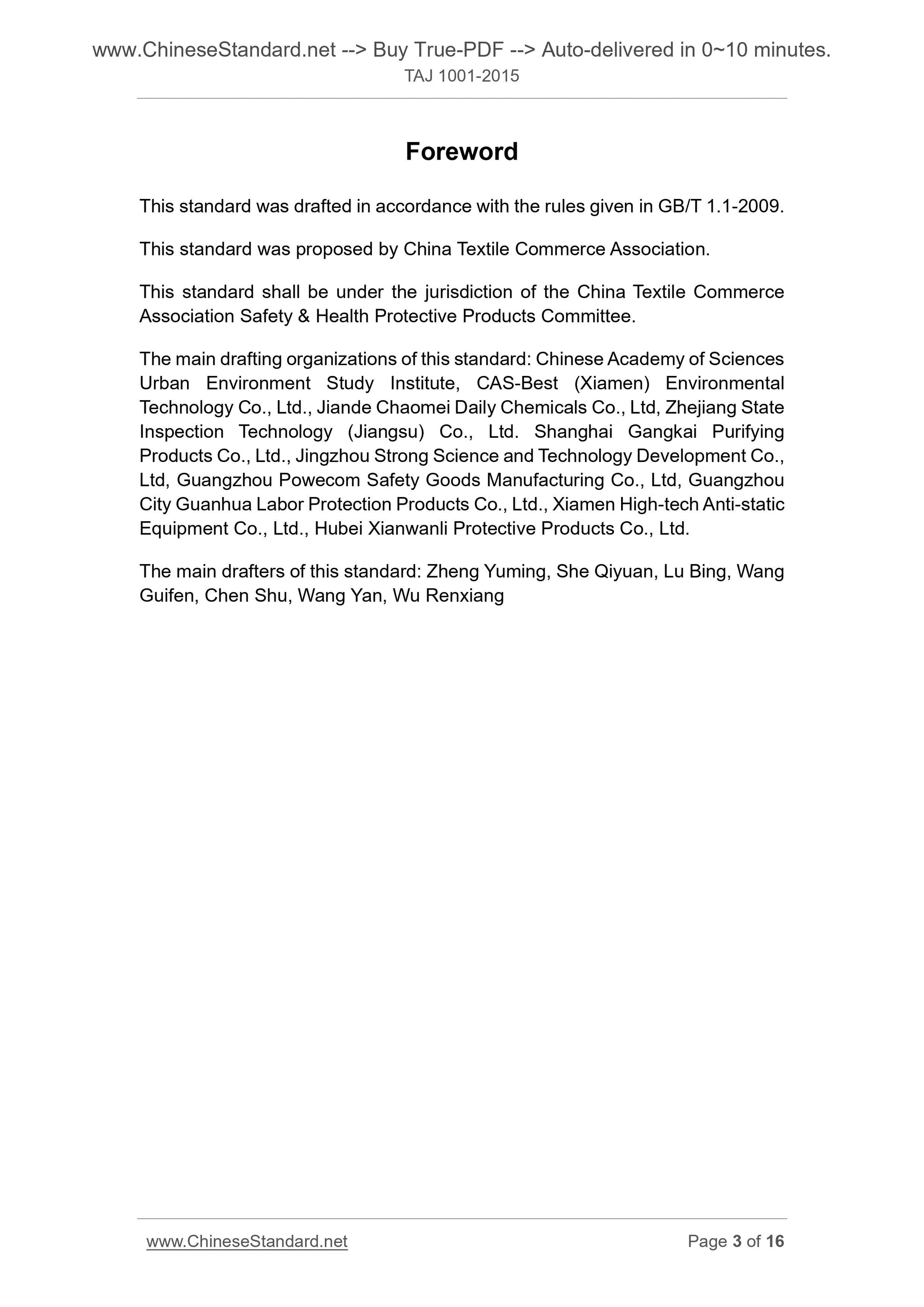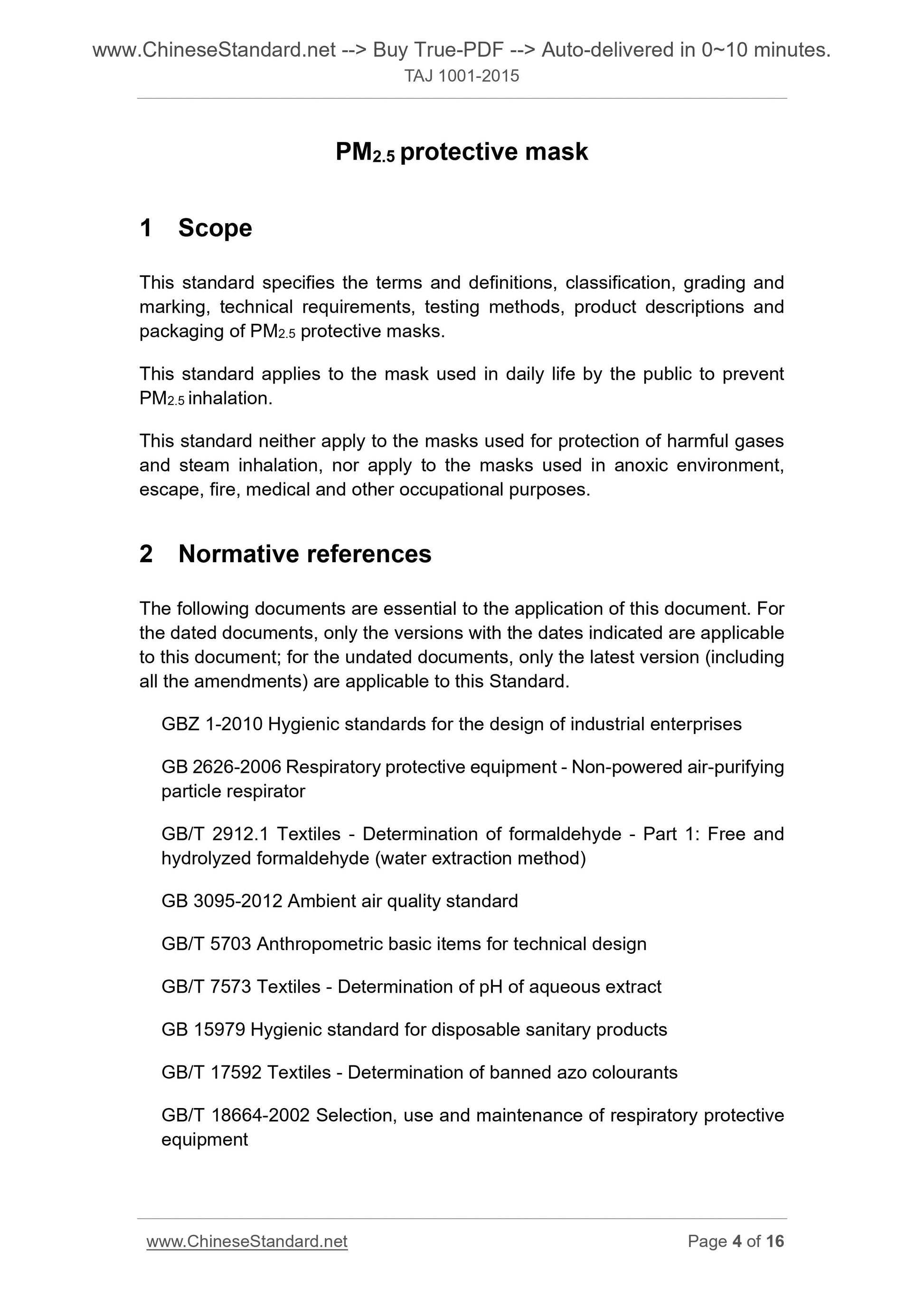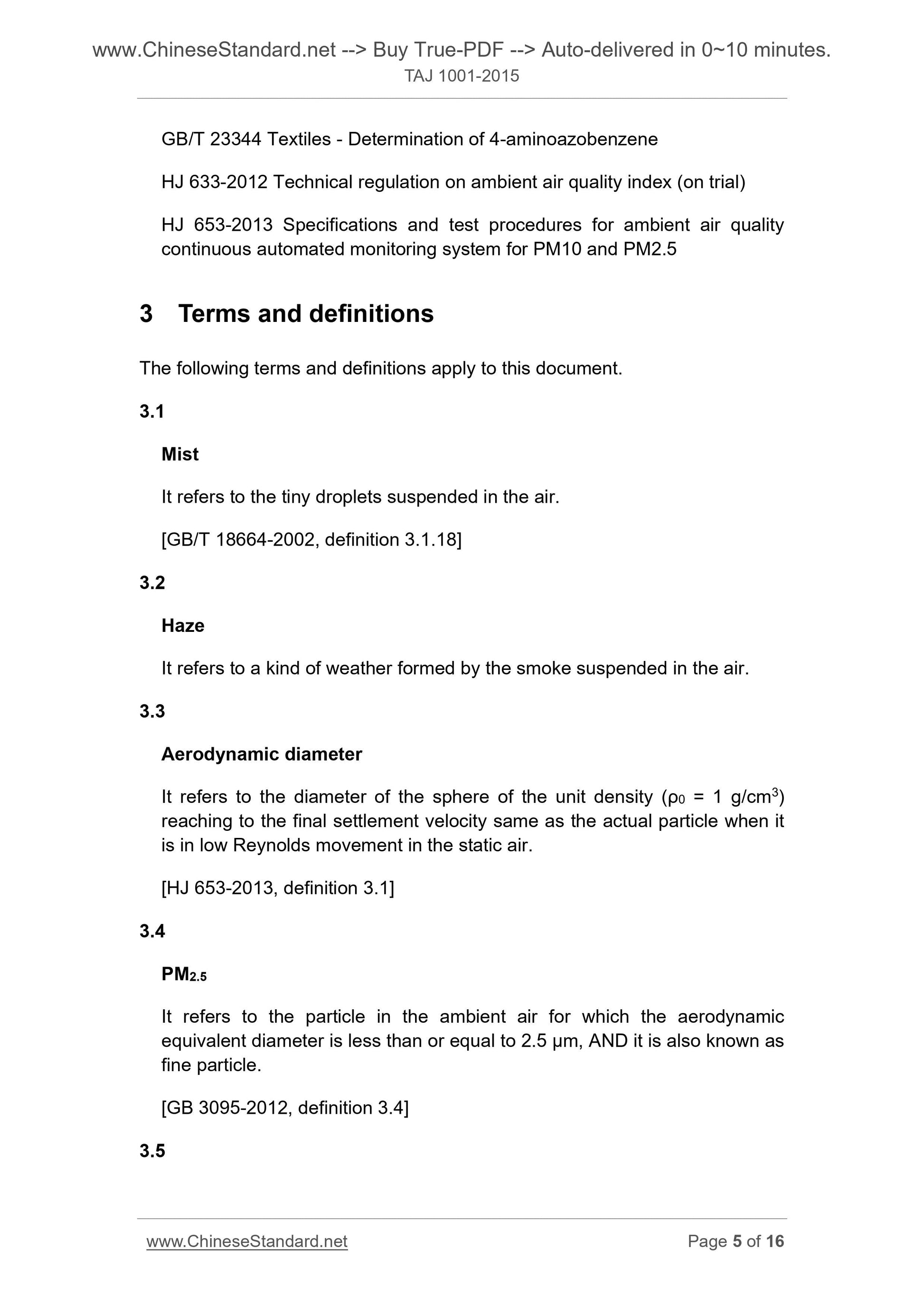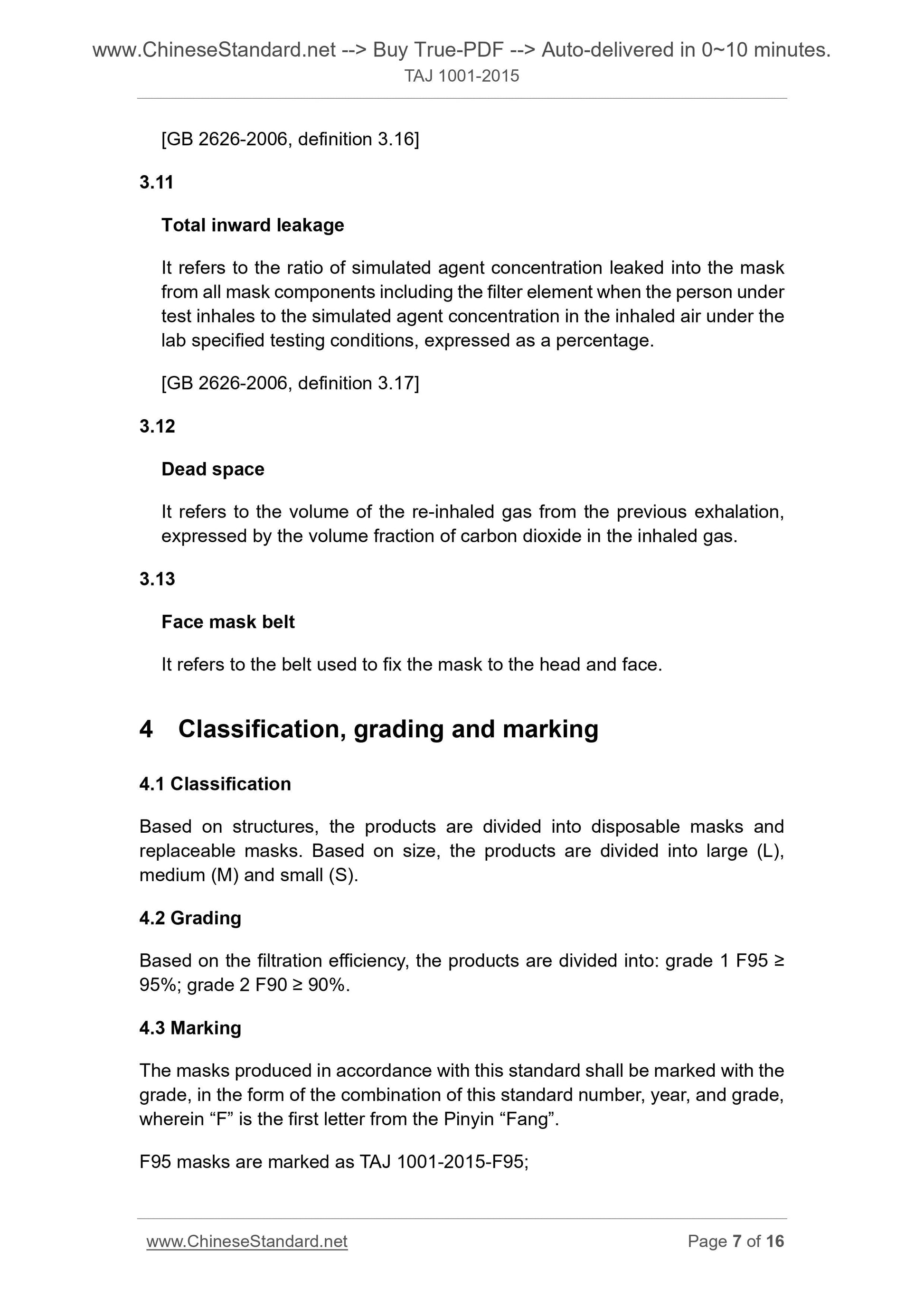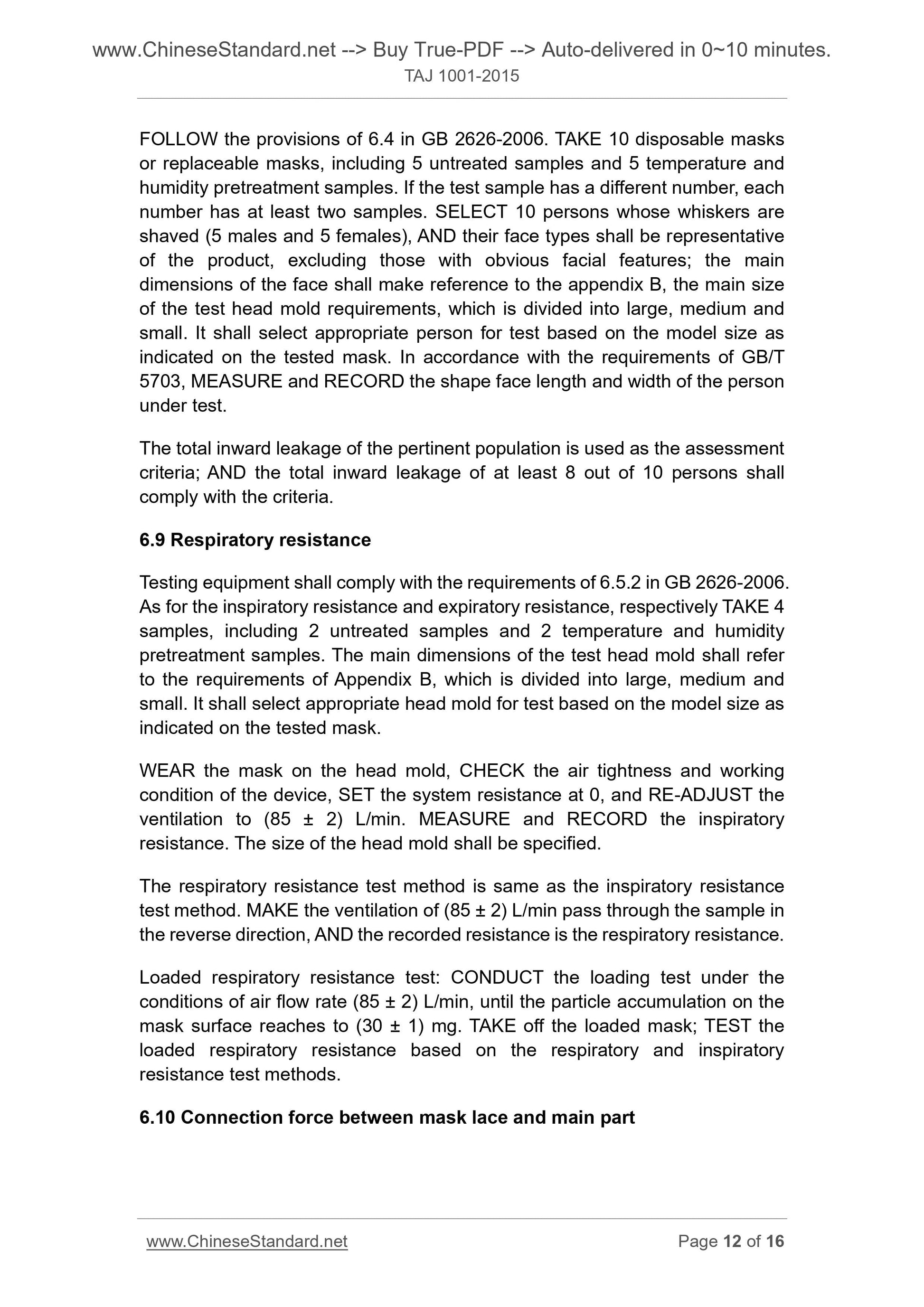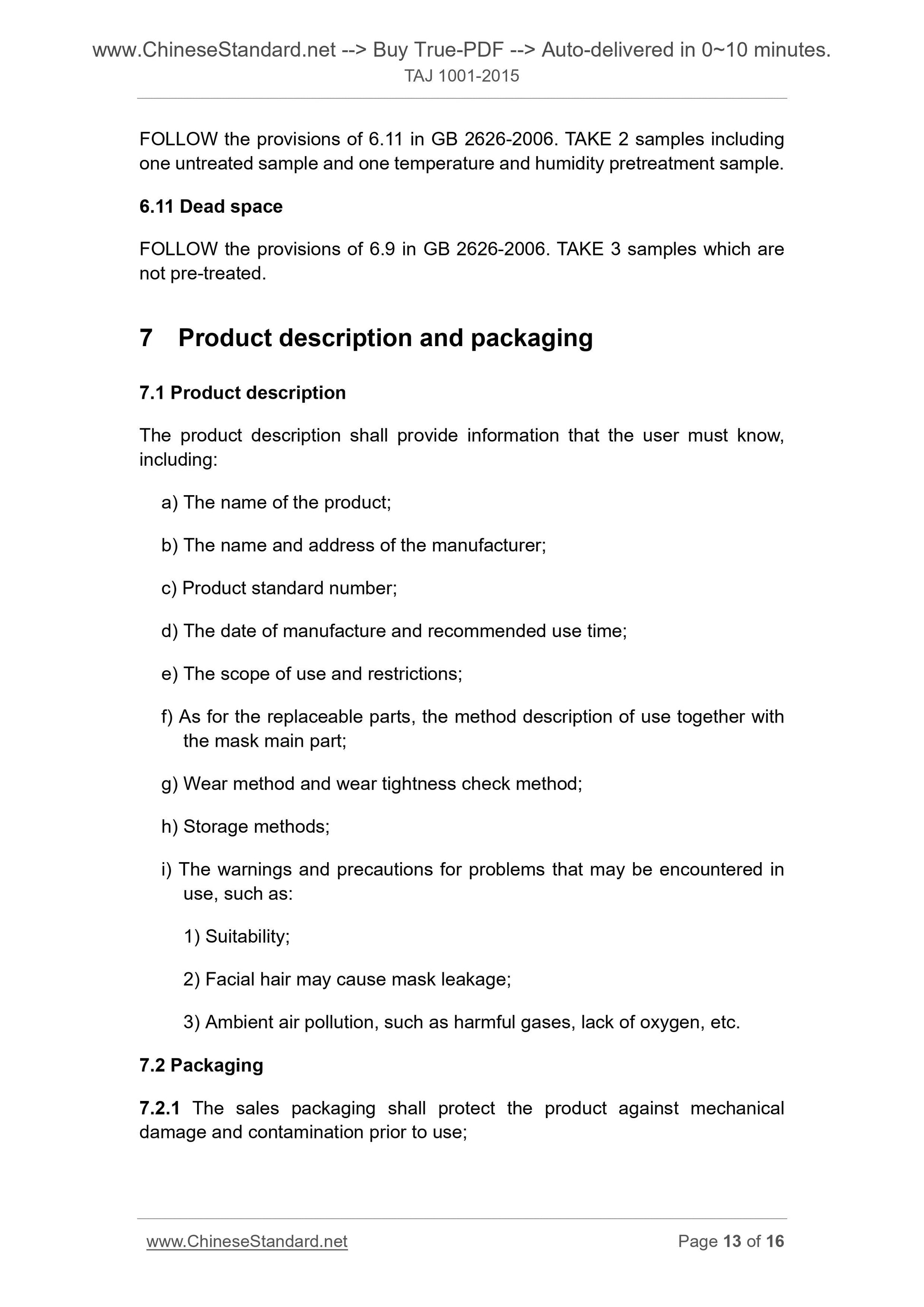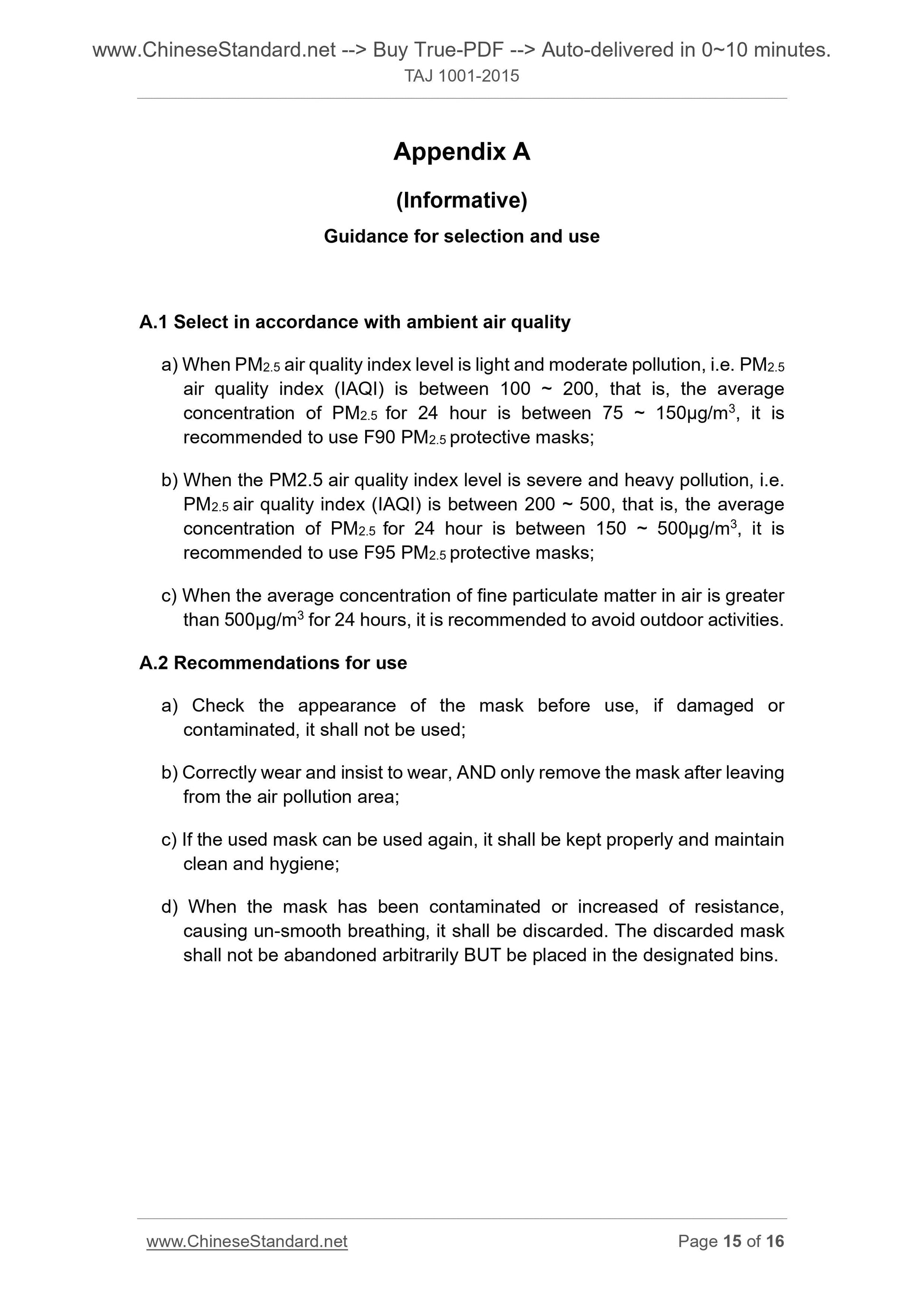1
/
of
9
PayPal, credit cards. Download editable-PDF and invoice in 1 second!
TAJ 1001-2015 English PDF (TAJ1001-2015)
TAJ 1001-2015 English PDF (TAJ1001-2015)
Regular price
$135.00 USD
Regular price
Sale price
$135.00 USD
Unit price
/
per
Shipping calculated at checkout.
Couldn't load pickup availability
Delivery: 3 seconds. Download true-PDF + Invoice.
Get QUOTATION in 1-minute: Click TAJ 1001-2015
Historical versions: TAJ 1001-2015
Preview True-PDF (Reload/Scroll if blank)
TAJ 1001-2015: PM2.5 protective mask
TAJ 1001-2015
AJ
ASSOCIATION STANDARD
OF CHINA TEXTILE COMMERCE ASSOCIATION
ICS 13.340.30
W 55
Registration number
PM2.5 protective mask
ISSUED ON. DECEMBER 1, 2015
IMPLEMENTED ON. MARCH 1, 2016
Issued by. China Textile Commerce Association
Table of contents
Foreword ... 3
1 Scope ... 4
2 Normative references ... 4
3 Terms and definitions ... 5
4 Classification, grading and marking ... 7
5 Technical requirements ... 8
6 Detection method ... 10
7 Product description and packaging ... 13
Appendix A (Informative) Guidance for selection and use ... 15
Appendix B (Informative) Main dimensions of test head molds ... 16
Foreword
This standard was drafted in accordance with the rules given in GB/T 1.1-2009.
This standard was proposed by China Textile Commerce Association.
This standard shall be under the jurisdiction of the China Textile Commerce
Association Safety and Health Protective Products Committee.
The main drafting organizations of this standard. Chinese Academy of Sciences
Urban Environment Study Institute, CAS-Best (Xiamen) Environmental
Technology Co., Ltd., Jiande Chaomei Daily Chemicals Co., Ltd, Zhejiang State
Inspection Technology (Jiangsu) Co., Ltd. Shanghai Gangkai Purifying
Products Co., Ltd., Jingzhou Strong Science and Technology Development Co.,
Ltd, Guangzhou Powecom Safety Goods Manufacturing Co., Ltd, Guangzhou
City Guanhua Labor Protection Products Co., Ltd., Xiamen High-tech Anti-static
Equipment Co., Ltd., Hubei Xianwanli Protective Products Co., Ltd.
The main drafters of this standard. Zheng Yuming, She Qiyuan, Lu Bing, Wang
Guifen, Chen Shu, Wang Yan, Wu Renxiang
PM2.5 protective mask
1 Scope
This standard specifies the terms and definitions, classification, grading and
marking, technical requirements, testing methods, product descriptions and
packaging of PM2.5 protective masks.
This standard applies to the mask used in daily life by the public to prevent
PM2.5 inhalation.
This standard neither apply to the masks used for protection of harmful gases
and steam inhalation, nor apply to the masks used in anoxic environment,
escape, fire, medical and other occupational purposes.
2 Normative references
The following documents are essential to the application of this document. For
the dated documents, only the versions with the dates indicated are applicable
to this document; for the undated documents, only the latest version (including
all the amendments) are applicable to this Standard.
GBZ 1-2010 Hygienic standards for the design of industrial enterprises
GB 2626-2006 Respiratory protective equipment - Non-powered air-purifying
particle respirator
GB/T 2912.1 Textiles - Determination of formaldehyde - Part 1. Free and
hydrolyzed formaldehyde (water extraction method)
GB 3095-2012 Ambient air quality standard
GB/T 5703 Anthropometric basic items for technical design
GB/T 7573 Textiles - Determination of pH of aqueous extract
GB 15979 Hygienic standard for disposable sanitary products
GB/T 17592 Textiles - Determination of banned azo colourants
GB/T 18664-2002 Selection, use and maintenance of respiratory protective
equipment
GB/T 23344 Textiles - Determination of 4-aminoazobenzene
HJ 633-2012 Technical regulation on ambient air quality index (on trial)
HJ 653-2013 Specifications and test procedures for ambient air quality
continuous automated monitoring system for PM10 and PM2.5
3 Terms and definitions
The following terms and definitions apply to this document.
3.1
Mist
It refers to the tiny droplets suspended in the air.
[GB/T 18664-2002, definition 3.1.18]
3.2
Haze
It refers to a kind of weather formed by the smoke suspended in the air.
3.3
Aerodynamic diameter
It refers to the diameter of the sphere of the unit density (ρ0 = 1 g/cm3)
reaching to the final settlement velocity same as the actual particle when it
is in low Reynolds movement in the static air.
[HJ 653-2013, definition 3.1]
3.4
PM2.5
It refers to the particle in the ambient air for which the aerodynamic
equivalent diameter is less than or equal to 2.5 μm, AND it is also known as
fine particle.
[GB 3095-2012, definition 3.4]
3.5
[GB 2626-2006, definition 3.16]
3.11
Total inward leakage
It refers to the ratio of simulated agent concentration leaked into the mask
from all mask components including the filter element when the person under
test inhales to the simulated agent concentration in the inhaled air under the
lab specified testing conditions, expressed as a percentage.
[GB 2626-2006, definition 3.17]
3.12
Dead space
It refers to the volume of the re-inhaled gas from the previous exhalation,
expressed by the volume fraction of carbon dioxide in the inhaled gas.
3.13
Face mask belt
It refers to the belt used to fix the mask to the head and face.
4 Classification, grading and marking
4.1 Classification
Based on structures, the products are divided into disposable masks and
replaceable masks. Based on size, the products are divided into large (L),
medium (M) and small (S).
4.2 Grading
Based on the filtration efficiency, the products are divided into. grade 1 F95 ≥
95%; grade 2 F90 ≥ 90%.
4.3 Marking
The masks produced in accordance with this standard shall be marked with the
grade, in the form of the combination of this standard number, year, and grade,
wherein “F” is the first letter from the Pinyin “Fang”.
F95 masks are marked as TAJ 1001-2015-F95;
FOLLOW the provisions of 6.4 in GB 2626-2006. TAKE 10 disposable masks
or replaceable masks, including 5 untreated samples and 5 temperature and
humidity pretreatment samples. If the test sample has a different number, each
number has at least two samples. SELECT 10 persons whose whiskers are
shaved (5 males and 5 females), AND their face types shall be representative
of the product, excluding those with obvious facial features; the main
dimensions of the face shall make reference to the appendix B, the main size
of the test head mold requirements, which is divided into large, medium and
small. It shall select appropriate person for test based on the model size as
indicated on the tested mask. In accordance with the requirements of GB/T
5703, MEASURE and RECORD the shape face length and width of the person
under test.
The total inward leakage of the pertinent population is used as the assessment
criteria; AND the total inward leakage of at least 8 out of 10 persons shall
comply with the criteria.
6.9 Respiratory resistance
Testing equipment shall comply with the requirements of 6.5.2 in GB 2626-2006.
As for the inspiratory resistance and expiratory resistance, respectively TAKE 4
samples, including 2 untreated samples and 2 temperature and humidity
pretreatment samples. The main dimensions of the test head mold shall refer
to the requirements of Appendix B, which is divided into large, medium and
small. It shall select appropriate head mold for test based on the model size as
indicated on the tested mask.
WEAR the mask on the head mold, CHECK the air tightness and working
condition of the device, SET the system resistance at 0, and RE-ADJUST the
ventilation to (85 ± 2) L/min. MEASURE and RECORD the inspiratory
resistance. The size of the head mold shall be specified.
The respiratory resistance test method is same as the inspiratory resistance
test method. MAKE the ventilation of (85 ± 2) L/min pa...
Get QUOTATION in 1-minute: Click TAJ 1001-2015
Historical versions: TAJ 1001-2015
Preview True-PDF (Reload/Scroll if blank)
TAJ 1001-2015: PM2.5 protective mask
TAJ 1001-2015
AJ
ASSOCIATION STANDARD
OF CHINA TEXTILE COMMERCE ASSOCIATION
ICS 13.340.30
W 55
Registration number
PM2.5 protective mask
ISSUED ON. DECEMBER 1, 2015
IMPLEMENTED ON. MARCH 1, 2016
Issued by. China Textile Commerce Association
Table of contents
Foreword ... 3
1 Scope ... 4
2 Normative references ... 4
3 Terms and definitions ... 5
4 Classification, grading and marking ... 7
5 Technical requirements ... 8
6 Detection method ... 10
7 Product description and packaging ... 13
Appendix A (Informative) Guidance for selection and use ... 15
Appendix B (Informative) Main dimensions of test head molds ... 16
Foreword
This standard was drafted in accordance with the rules given in GB/T 1.1-2009.
This standard was proposed by China Textile Commerce Association.
This standard shall be under the jurisdiction of the China Textile Commerce
Association Safety and Health Protective Products Committee.
The main drafting organizations of this standard. Chinese Academy of Sciences
Urban Environment Study Institute, CAS-Best (Xiamen) Environmental
Technology Co., Ltd., Jiande Chaomei Daily Chemicals Co., Ltd, Zhejiang State
Inspection Technology (Jiangsu) Co., Ltd. Shanghai Gangkai Purifying
Products Co., Ltd., Jingzhou Strong Science and Technology Development Co.,
Ltd, Guangzhou Powecom Safety Goods Manufacturing Co., Ltd, Guangzhou
City Guanhua Labor Protection Products Co., Ltd., Xiamen High-tech Anti-static
Equipment Co., Ltd., Hubei Xianwanli Protective Products Co., Ltd.
The main drafters of this standard. Zheng Yuming, She Qiyuan, Lu Bing, Wang
Guifen, Chen Shu, Wang Yan, Wu Renxiang
PM2.5 protective mask
1 Scope
This standard specifies the terms and definitions, classification, grading and
marking, technical requirements, testing methods, product descriptions and
packaging of PM2.5 protective masks.
This standard applies to the mask used in daily life by the public to prevent
PM2.5 inhalation.
This standard neither apply to the masks used for protection of harmful gases
and steam inhalation, nor apply to the masks used in anoxic environment,
escape, fire, medical and other occupational purposes.
2 Normative references
The following documents are essential to the application of this document. For
the dated documents, only the versions with the dates indicated are applicable
to this document; for the undated documents, only the latest version (including
all the amendments) are applicable to this Standard.
GBZ 1-2010 Hygienic standards for the design of industrial enterprises
GB 2626-2006 Respiratory protective equipment - Non-powered air-purifying
particle respirator
GB/T 2912.1 Textiles - Determination of formaldehyde - Part 1. Free and
hydrolyzed formaldehyde (water extraction method)
GB 3095-2012 Ambient air quality standard
GB/T 5703 Anthropometric basic items for technical design
GB/T 7573 Textiles - Determination of pH of aqueous extract
GB 15979 Hygienic standard for disposable sanitary products
GB/T 17592 Textiles - Determination of banned azo colourants
GB/T 18664-2002 Selection, use and maintenance of respiratory protective
equipment
GB/T 23344 Textiles - Determination of 4-aminoazobenzene
HJ 633-2012 Technical regulation on ambient air quality index (on trial)
HJ 653-2013 Specifications and test procedures for ambient air quality
continuous automated monitoring system for PM10 and PM2.5
3 Terms and definitions
The following terms and definitions apply to this document.
3.1
Mist
It refers to the tiny droplets suspended in the air.
[GB/T 18664-2002, definition 3.1.18]
3.2
Haze
It refers to a kind of weather formed by the smoke suspended in the air.
3.3
Aerodynamic diameter
It refers to the diameter of the sphere of the unit density (ρ0 = 1 g/cm3)
reaching to the final settlement velocity same as the actual particle when it
is in low Reynolds movement in the static air.
[HJ 653-2013, definition 3.1]
3.4
PM2.5
It refers to the particle in the ambient air for which the aerodynamic
equivalent diameter is less than or equal to 2.5 μm, AND it is also known as
fine particle.
[GB 3095-2012, definition 3.4]
3.5
[GB 2626-2006, definition 3.16]
3.11
Total inward leakage
It refers to the ratio of simulated agent concentration leaked into the mask
from all mask components including the filter element when the person under
test inhales to the simulated agent concentration in the inhaled air under the
lab specified testing conditions, expressed as a percentage.
[GB 2626-2006, definition 3.17]
3.12
Dead space
It refers to the volume of the re-inhaled gas from the previous exhalation,
expressed by the volume fraction of carbon dioxide in the inhaled gas.
3.13
Face mask belt
It refers to the belt used to fix the mask to the head and face.
4 Classification, grading and marking
4.1 Classification
Based on structures, the products are divided into disposable masks and
replaceable masks. Based on size, the products are divided into large (L),
medium (M) and small (S).
4.2 Grading
Based on the filtration efficiency, the products are divided into. grade 1 F95 ≥
95%; grade 2 F90 ≥ 90%.
4.3 Marking
The masks produced in accordance with this standard shall be marked with the
grade, in the form of the combination of this standard number, year, and grade,
wherein “F” is the first letter from the Pinyin “Fang”.
F95 masks are marked as TAJ 1001-2015-F95;
FOLLOW the provisions of 6.4 in GB 2626-2006. TAKE 10 disposable masks
or replaceable masks, including 5 untreated samples and 5 temperature and
humidity pretreatment samples. If the test sample has a different number, each
number has at least two samples. SELECT 10 persons whose whiskers are
shaved (5 males and 5 females), AND their face types shall be representative
of the product, excluding those with obvious facial features; the main
dimensions of the face shall make reference to the appendix B, the main size
of the test head mold requirements, which is divided into large, medium and
small. It shall select appropriate person for test based on the model size as
indicated on the tested mask. In accordance with the requirements of GB/T
5703, MEASURE and RECORD the shape face length and width of the person
under test.
The total inward leakage of the pertinent population is used as the assessment
criteria; AND the total inward leakage of at least 8 out of 10 persons shall
comply with the criteria.
6.9 Respiratory resistance
Testing equipment shall comply with the requirements of 6.5.2 in GB 2626-2006.
As for the inspiratory resistance and expiratory resistance, respectively TAKE 4
samples, including 2 untreated samples and 2 temperature and humidity
pretreatment samples. The main dimensions of the test head mold shall refer
to the requirements of Appendix B, which is divided into large, medium and
small. It shall select appropriate head mold for test based on the model size as
indicated on the tested mask.
WEAR the mask on the head mold, CHECK the air tightness and working
condition of the device, SET the system resistance at 0, and RE-ADJUST the
ventilation to (85 ± 2) L/min. MEASURE and RECORD the inspiratory
resistance. The size of the head mold shall be specified.
The respiratory resistance test method is same as the inspiratory resistance
test method. MAKE the ventilation of (85 ± 2) L/min pa...
Share
